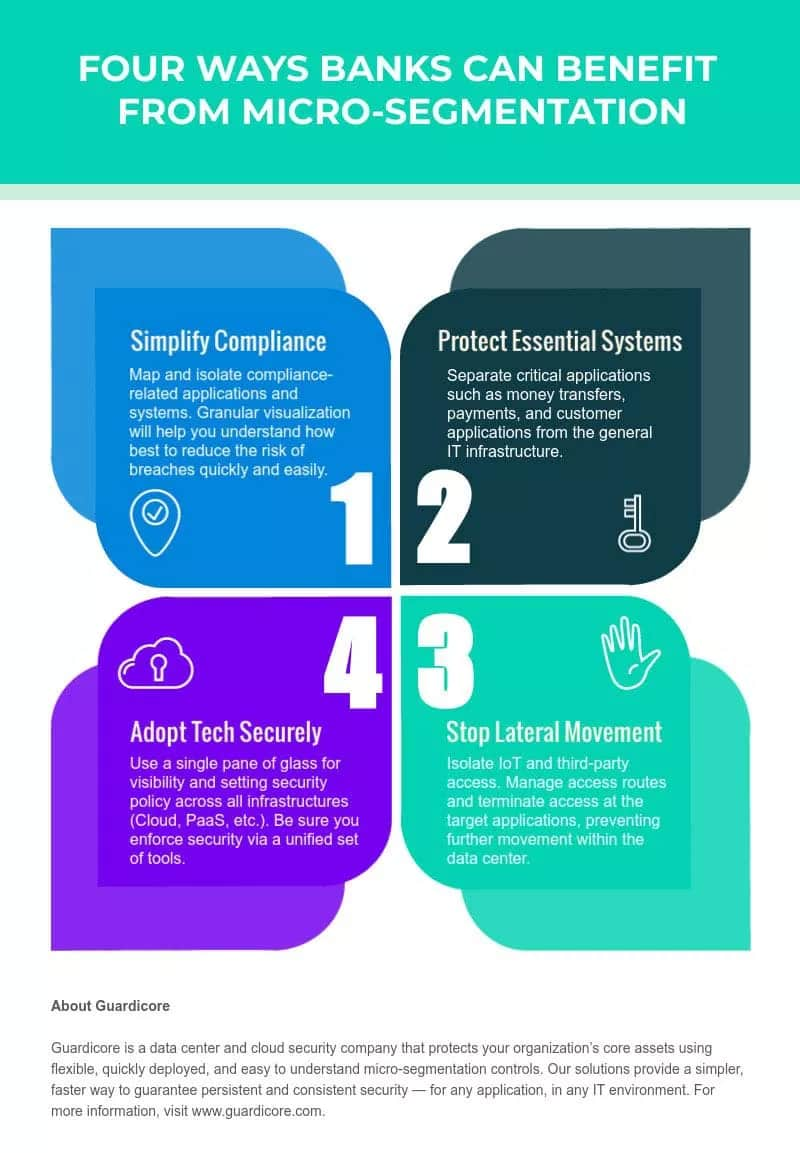Banks Prioritizing Microsegmentation

Micro-segmentation allows financial institutions to achieve a number of key goals while protecting their crown jewels through a single, straightforward approach.
Financial institutions have a strong requirement for cost-savings through automation, resources optimization, and agile technologies. They need a solution that can increase security while also promoting operational efficiency.
Moreover, financial institutions have always been prime targets for crime. According to Forbes, cyberattacks cost financial institutions more to address than firms in any other industries. Given that remote and indirect transactions are the norm these days, attackers have even more opportunities to break through perimeter security. This further increases the risk of breach and the remediation costs.
How can banks use microsegmentation to solve these issues? Let’s take a look.
What are the cyber-security challenges banks face?
Managing cyber security controls in financial services is a complex task. There are numerous drivers that make the work time-consuming and resource-heavy, such as:
- There are country- and state-level cyber security requirements that need to be followed, not to mention vendor security mandates and various privacy regulations. Altogether, they impose a vast number of reporting and risk-management challenges.
- Modern banking heavily relies on a large number of third-party applications, partners, and outsourcing vendors accessing the data center via a variety of access routes.
- The evolving network infrastructure leaves organizations with a cloud technology and legacy systems mix, in a tangled environment that is hard to visualize, audit, and protect.
All those factors combined with a multitude of tools, users, and outside pressures makes financial institutions especially vulnerable to cybercrime.
Enabling digital transformation for better customer service and availability leads to even more ways for banks to be vulnerable to fraud and unauthorized transactions. Customers are well aware of these growing issues and want reassurance that their privacy and finances are protected.
“Customers are becoming increasingly aware of cybersecurity threats and they expect their banks and credit unions to secure and protect their private financial information.”
~ Credit Union Council (CUC), FS-ISAC, 2019
“Banks have validated this trend by reporting that losses due to operational disruption and losses in customer trust are more financially damaging than losses due to regulatory fines.”
~ Deloitte and FS-ISAC Cybersecurity Benchmarking Analysis, 2019
Four ways banks can benefit from microsegmentation
The best way to address these challenges is to create a single pane of glass for security, with complete network traffic visibility and full isolation of the digital crown jewels. Using flexible, quickly deployed, and easy-to-understand microsegmentation controls, financial institutions can protect their core assets simply and effectively.
In order to get the most from a microsegmentation solution, there are four critical steps to take:
1. Simplify and accelerate regulatory compliance
To achieve this goal, start by mapping everything and isolating all compliance-related applications and systems. Granular visualization will help you understand how best to reduce the risk of breaches quickly and easily.
2. Protect your essential systems
Separate critical applications such as money transfers, payments, and customer applications from the general IT infrastructure.
3. Prevent unauthorized lateral movement
Properly isolate IoT and third-party access. In addition, manage access routes and terminate access at the target applications, preventing further movement within the data center.
4. Adopt Cloud, PaaS, and other emerging technology cost-effectively and securely
Use a single pane of glass for visibility and setting security policy across all infrastructures. In addition, be sure you enforce security via a unified set of tools.

How microsegmentation works in real life
Need proof that the microsegmentation approach works? Here is an example of a Guardicore customer – a US regional bank – which was able to produce vast improvements utilizing Guardicore Centra’s visualization and microsegmentation capabilities.
This bank had a few initiatives in place:
- Comply with the Fedline mandate to isolate any Fedline Service-connected application from general IT.
- Ring-fence ten of their most critical applications to significantly reduce cyber risks and ensure business continuity in case of breach.
- Limit third-party access to enforce Zero Trust access controls.
- Make it possible to migrate applications securely to the cloud.
- Maintain a single set of security controls across the entire hybrid infrastructure.
With a single security architect, over the course of two months, the customer was able to meet all of their goals beyond original expectations. Ultimately, they were able to:
- Achieve granular east-west traffic visibility.
- Ring-fence their business critical applications.
- Restrict and properly route third-party access.
- Map applications’ dependencies for seamless cloud migration.
- Achieve full process automation with the DevOps integration.
Looking for more? Here’s what some of our other customers have to say:
“Guardicore enables us to enhance our overall data center security strategy and help our IT security team to avoid today’s advanced threats.”
~ Marino Aguiar, CIO, Santander Brasil
“Deutsche Bank is committed to the highest standards of security, and a high priority for us is implementing tight network segmentation in our on-premises and cloud environments. Guardicore gives us an effective way to protect our critical assets through segmentation.”
~ Alan Meirzon, Director, Chief Information Security Officer
Use microsegmentation to protect your crown jewels today
With simple and easy to manage microsegmentation controls, financial institutions can reduce attack surface and quickly detect breaches within the data center. Deep visibility into applications’ dependencies and traffic flows helps to enforce precise network and process-level policies that isolate critical applications and systems.
Don’t forget to look for a tool that provides complete security coverage for applications, regardless where they reside. After all, most financial institutions need to protect workloads that span across platforms and environments: on-premise, legacy and bare metal, VMs, containers, and public and private clouds (including Amazon Web Services, Microsoft Azure, Google Cloud and Oracle Cloud Infrastructures).
Want to delve into more details? Watch the Regional Banking Webinar and learn more about how Guardicore can help you today!



